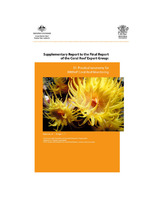Please use this identifier to cite or link to this item:
https://hdl.handle.net/11017/3563

Full metadata record
| DC Field | Value | Language |
|---|---|---|
| dc.contributor.author | Babcock, R. | - |
| dc.contributor.author | Bridge, T. | - |
| dc.date.accessioned | 2020-02-27T04:43:45Z | - |
| dc.date.available | 2020-02-27T04:43:45Z | - |
| dc.date.copyright | 2020 | en |
| dc.date.issued | 2020 | en |
| dc.identifier.isbn | 9780648589266 | en |
| dc.identifier.uri | https://hdl.handle.net/11017/3563 | - |
| dc.description.abstract | [Extract] Current approaches used in benthic monitoring programs, particularly with respect to classifying benthic substrata and biota, were reviewed to provide the basis of recommendations in relation to the practical application of standardised and easily integrated approaches. The basis for these recommendations are that they are appropriate in terms of generating information that is both fit-for-purpose and cost-effective in terms of informing management decisions, providing for consistent current and future reporting mechanisms, and for generating new scientific understanding through its application in longitudinal ecological observations. Importantly, consideration was also given to applications that had the potential to be used in or applied to provide a common basis for integrating disparate current monitoring programs within the Reef 2050 Integrated Monitoring and Reporting Program (RIMReP). Such integration can only be achieved when data standardisation and compatibility among methodologies is assured. Furthermore, the standardisation of classifications will be important in facilitating machine learning and helping monitoring programs transition to automated image processing which has the potential to greatly expand the scope and timeliness of monitoring programs on the Great Barrier Reef (the Reef). Candidate classification schemes are discussed and it is recommended that a scheme such as CATAMI (Collaborative and Automated Tools for Analysis of Marine Imagery) which is already widely used in Australia, be adopted and tailored using input from all stakeholders for use by Reef monitoring programs. | en |
| dc.description.abstract | An accessible copy of this report is not yet available from this repository, please contact elibrary@gbrmpa.gov.au for more information. | en |
| dc.publisher | Great Barrier Reef Marine Park Authority | en |
| dc.relation.ispartofseries | Reef 2050 | en |
| dc.relation.ispartofseries | Coral Reef Expert Group (RIMRep) | en |
| dc.rights | © Commonwealth of Australia (Australian Institute of Marine Science) 2020. This document is licensed for use under a Creative Commons Attribution-NonCommercial 4.0 International licence with the exception of the Coat of Arms of the Commonwealth of Australia, the logos of the Great Barrier Reef Marine Park Authority and the Queensland Government, any other material protected by a trademark, content supplied by third parties and any photographs. For licence conditions see: https://creativecommons.org/licenses/by-nc/4.0/ | en |
| dc.subject.other | Reef Ecosystems & Marine Species | en |
| dc.title | Supplementary report to the final report of the coral reef expert group: S1. Practical taxonomy for RIMReP coral reef monitoring | en |
| dc.type | Report | en |
| dc.subject.asfa | Classification (biological) | en |
| dc.subject.asfa | Taxonomy | en |
| dc.format.pages | 12 | en |
| dc.contributor.corpauthor | Australian Institute of Marine Science | en |
| dc.publisher.place | Townsville | en |
| dc.relation.connectiontogbrmpa | GBRMPA published this item | en |
| dc.subject.category | Ecosystems | en |
| dc.subject.location | Reef-wide | en |
| dc.keywords | Reef 2050 | en |
| Appears in Collections: | Ecosystems | |
Files in This Item:
| File | Description | Size | Format | |
|---|---|---|---|---|
| Coral Reef Supplementary Report 1.pdf | Main report (PDF) | 1.49 MB | Adobe PDF |  View/Open |
This item is licensed under a Creative Commons License

